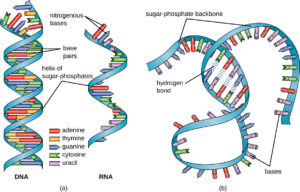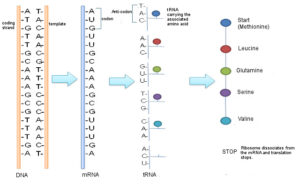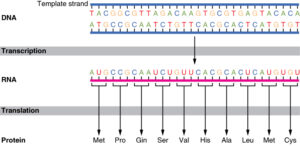DNA is a chemical molecule that has all the genetic information of specific organisms in which they are present. Here arises a question, Explanation on the sequence of nitrogenous bases in DNA. Let’s see in this article.
The sequence of nitrogenous bases in DNA do not follow a specific or particular order but yes, they are COMPLEMENTARY to each other to which the amino acids get coded, that is the nucleotides pair up specifically making the strand complementary to each other.
DNA strands have four nitrogenous bases which are guanine, adenine, thymine and cytosine.
Before heading into the concept of Sequence Of Nitrogenous Bases In DNA, We need to understand the structure of DNA.
The DNA has three major components
- The Nitrogenous Base– The subunits of DNA which are discussed in detail in this article.
- The Sugar Molecule- The deoxyribose sugar
- The Phosphate Group– The highly negative portion and the backbone of the complete structure.

Image Credits: Wikimedia
What is the Pairing Sequence of Nitrogenous Bases in DNA?
There are 2 classes of compounds- Purine and Pyrimidine. In DNA, there are about four nitrogenous bases.
The chemical molecule- Purine in DNA are Guanine – G and Adenine – A. The chemical molecule- Pyrimidine in DNA are Thymine – T and Cytosine – C. The pairing up of these nitrogenous bases in DNA is the purine pairs up with the pyrimidine molecule and Pyrimidine molecule with the Purine molecule.
So Adenine (Purine) pairs up with Thymine (Pyrimidine) and Cytosine (Pyrimidine) pairs up with Guanine (Purine).
This explains the pairing sequence of DNA’s nitrogenous bases.

Image Credits: Wikimedia
Read More on DNA Structure | A detailed insight with all crucial aspects
What is the Main Purpose of the Sequences of Nitrogenous Bases in DNA?
The nitrogenous bases are like the foundation of DNA and RNA which is collectively known as Nucleic acids.
The main purpose of sequences of nitrogenous bases in DNA is to store the genetic information of the organisms in them.
What does the Order of Nitrogenous Bases in DNA Determine?
The order of nitrogenous bases in DNA is complementary to each other.
The order of nitrogenous bases in DNA is arranged in such a way that they code for the protein molecule (that is Amino acids).

Image Credits: Wikimedia
Example:
One strand of DNA is
A T T G C A T A G G G G C C T T T A A C C T G G C A T A G G
The complementary strand will be
T A A C G T A T C C C C G G A A A T T G G A C C G T A T C C

Image Credits: Wikimedia
Read More on DNA Replication Steps and Critical FAQs
Why is the sequence of nitrogenous bases in dna important?
Nitrogenous bases are simply known as nitrogen bases, that is the molecules are made up of nitrogen atoms and are a replica of base.
Proteins are the fundamental unit or the primary molecule of every cell in the living organisms. The significance of the DNA’s nitrogenous bases is only when the right or relevant nitrogenous bases pairs up with the relevant one or the right one, the protein synthesis takes place and the right amino acid is coded.
The nitrogen in these nitrogen bases are the constructive material of the nucleic acids.
When the right nitrogenous bases are paired up and the coding of protein is done that’s when the organism’s protein- cellular mechanism is fulfilled.
Read More on Do Bacteria Have DNA :Why,How And Detailed Insights
How genetic information can be stored in a sequence of nitrogenous bases in DNA?
It looks so fascinating that how come DNA stores the genetic information of specific organisms.
The nitrogenous bases in the DNA stores that genetic information. The minute component in the cell stores so much information. The nitrogenous bases code for specific amino acid molecules which collectively make up protein and the complete living mechanisms take place.
The central dogma: DNA is converted into mRNA (Transcription process) and then transformed to Protein molecule- Amino acids subunits (Translation process).

Image credits: Wikimedia
Here are a few bases and their corresponding amino acids.
- T T T and T T C – Codes for Phenylalanine Amino Acid Molecule.
- T T A and T T G- Codes for Leucine Amino Acid Molecules.
- T C T , T C C , T C A , T C G- Codes for Serine Amino Acid Molecules.
- T A T and T A C- Codes for Tyrosine amino acid molecule.
- T G T and T G C- Codes for Cysteine Amino Acid Molecule
- G G T , G G C , G G A , G G G- Codes for Glycine Amino Acid Molecule.
Also Read:
- Dna transcription enzyme
- Antiparallel dna strands 2
- Do prokaryotes have dna replication
- Dna replication vs polymerase
- Chromatin organization impact on packaging of dna
- Uracil in dna replication
- Is prokaryotic dna a double helix
- Dna transcription diagram

Hello, I am Sugaprabha Prasath, a Postgraduate in the field of Microbiology. I am an active member of the Indian association of applied microbiology (IAAM). I have research experience in preclinical (Zebrafish), bacterial enzymology, and nanotechnology. I have published 2 research articles in an International journal and a few more are yet to be published, 2 sequences were submitted to NCBI-GENBANK. I am good at clearly explaining the concepts in biology at both basic and advanced levels. My area of specialization is biotechnology, microbiology, enzymology, molecular biology, and pharmacovigilance. Apart from academics, I love gardening and being with plants and animals.
My LinkedIn profile-